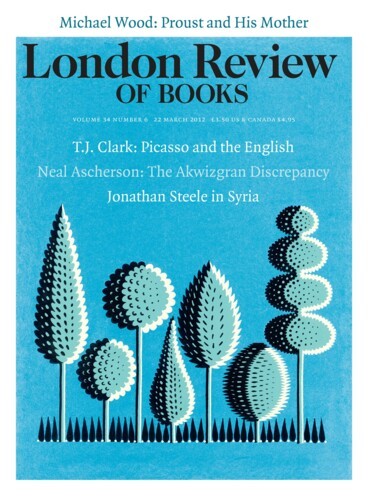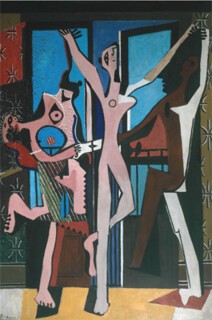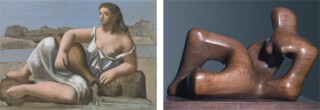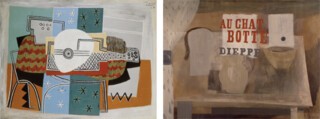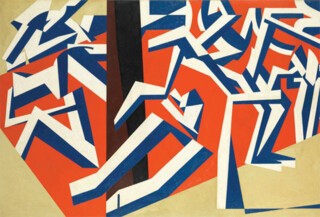I would like to get the generalisations over with at the beginning, and have them be brief, but part of me knows that once embarked on they’ll be hard to stop. The Tate’s is the kind of show that sets one generalising. Richard Dorment in the Daily Telegraph, for instance, wrote that it had managed ‘to take a non-subject (Picasso’s impact here was limited to a handful of artists) and turn it into a gripping indictment of British culture in the first half of the 20th century’. If Britain here means England, I fall in reluctantly with the Telegraph’s verdict. Picasso’s was a uniquely difficult achievement to respond to, and many artists, in all parts of the globe, wished he hadn’t been there. There is a famous story of Lee Krasner hearing a book go hurtling across the studio next to hers, smashing against a wall, and Jackson Pollock emerging with the words: ‘Goddamn it! That guy has done everything. There’s nothing left.’ But the further point of the anecdote is that Pollock did find ways, eventually, to turn the ‘everything’ to his advantage. That was partly because he belonged to an embattled, arrogant, entirely serious modern art culture – Arshile Gorky, Willem de Kooning, Krasner, Hans Hofmann, the sculptor David Smith – which had spent a decade submitting to the master. ‘Aha,’ Gorky is supposed to have said coldly to de Kooning on first being shown the younger artist’s Picasso-saturated work, ‘so you have ideas of your own.’ Picasso’s aren’t good enough for you?
Modernism is a strange artistic formation. In it, time and again, originality – which remains anachronistically the goal – lies on the other side of subservience. There is no such thing, it turns out in practice, as well-tempered learning in modernism, reasonable apprenticeship, picking and choosing the imitable. And this is a problem particularly for a genteel art culture – for a culture like England’s, whose arrogance over the past century has been most powerfully manifest in its false moderacy.
But I get ahead of myself. Two things need establishing. First, that Picasso’s instigation, difficult as it was, did prove time and again in other nations a spur to major art. What Malevich and Tatlin were able to do with Picasso’s Cubism between 1912 and 1917; how Mondrian thought through the same style’s implications in Paris, and what he did, on returning to Holland, to make what he had learned usable in a shared project; the long-distance Picasso-olatry of the New York School; even the scrupulous Cubism of the Czechs before 1914 – these are moments that sum up, for me, the true intensity and dignity of modernism. And for a culture signally to lack such a moment is a weakness – maybe even an indictment.
But why? For it cannot be – this is my second point – that failure to respond to a strong, perplexing exemplar is in itself a sign of a culture in retreat. I do not think, to go back a century, that anyone in Britain was capable of responding to the achievement of Turner. This no doubt set limits on the painting that followed (the fact that Monet and others in France were capable is one clue to their painting culture’s strength), but it did not mean that the Pre-Raphaelites, to name his main inheritors, were in any sense an evasive or secondary movement. On the contrary: they believed they were duty bound to reject Turner’s idiosyncrasy and worldliness, and that by doing so they would speak to the central concerns and assumptions of the nation – its apostolic religiosity, its appetite for story, its moral high tension, its relish for detail. And they did. No one in their right mind would say (I hope) that The Light of the World is the same kind of achievement as The Blue Rigi or Interior at Petworth; but it is an achievement: it cares nothing for artistic good manners; it is not in hiding from the agonies of its age.
Almost all visual art made in Britain in the 20th century has the instinct of hiding (and good manners) built into its every move – and this includes art that had no doubt it was piling on the agony, indeed in a ‘Picasso’ kind of way. (There is a scare-quotes ‘Picasso’-ism, all rending and tearing and leering and terribilità, at the heart of the pseudo-culture of art from 1910 on; and off to one side there is Picasso-ism for real. Wyndham Lewis is a good example of the first; Gorky and de Kooning of the second. Francis Bacon started, so the Tate show demonstrates, as a diligent – too diligent – student of the second kind, battling away at the enigma of Cubist space; he failed to solve it; and where he ended up is another matter.)
The question remains why. What stood in the way of the English doing as well as the Czechs or the Dutch? My answer begins from the special hold here of class on culture. The culture of art in England is genteel. It is tied to Home Counties, late-imperial class values and attitudes in ways – with a depth and tightness of affiliation – that mark it out from Turin or St Petersburg or Prague or Paris, or even Habsburg Vienna. This has nothing to do, need I say it, with the actual vileness of any particular bourgeoisie. It depends on the means – the insistence, the ‘givenness’ – of that bourgeoisie’s hegemony. And of course there are art forms in which gentility is not (apparently) debilitating. The novel, for one: it can make gentility its subject. The subject may strike one, the more one rereads, as a minor and exhaustible one, if put alongside the accounts of being-in-the-social-world available to the Irish, say, or the Russians or Americans. I used to laugh in California at the way American students of modern literature were more likely to have read the (ludicrous) accounts of class in Mrs Dalloway or Howards End than that of race in Light in August. But the English novel in the 20th century, I concede, is something. It has the power to offend; it has the courage of its class convictions. There is no visual art in the same period of which this can be said.
Sculpture in England is a special case. I shall put it aside, essentially, till I come to Henry Moore, whose room in the Tate exhibition is far and away the strongest. But simply this, for the present: sculpture had the advantage, it seems to me, if our subject is metropolitan taste, of being always a less mannerly, more laborious art. It was a handicraft. It is surely no coincidence that its strongest exponents in Britain were provincials, who managed shrewdly to put this (minor) exoticism to good use, career-wise. And further – I cannot decide if this is coincidence or part of the same story – sculpture was associated from the beginning in the 20th century with the genuinely scandalous. Jacob Epstein was an embarrassing figure. Even in Paris his work looked appalling. Bloomsbury recoiled from him as much as Fleet Street (with its usual hypocritical populism) did. Jews and Frenchmen – Epstein and Gaudier-Brzeska – made the avant-garde running before 1914. They dragged Eric Gill into their disreputable erotico-primitive force field. By the time Moore and Barbara Hepworth (Hepworth is a great absence at the Tate) came on the scene, the strong early moment of sculpture had dissipated, but not completely: the world of stone and plaster retained a little – just enough – of the initial charge, the Whitechapel shrugging-off of proper form.
There are kinds of art in England, to repeat, where gentility is not the determining horizon. (Poetry, with its bizarre contest between Americans-in-London and cultivated lower-middle ‘provincial’ bathos, took its own unpredictable path.) So why did it prove to be so with painting? The answer derives, I think, from painting’s unique vulnerability to its patrons. Painting, from the 1860s on, was the central modernist art – I follow Mallarmé and Nietzsche in this – precisely because it hovered constantly, constitutively, on the edge of complete assimilation to an upper-class ethos of aesthetic novelty, refined cuisine, ‘daring’ entertainment. The closeness was a threat, and most artists succumbed to it; but for a few it clarified matters in ways no other art form could match: it forced painters to define what could set painting apart from its parent culture, and induced them to build an elaborate protective carapace within which the cult of art – the idea of order and intensity, the dream of inviolable aesthetic distance – might be pursued in safety. Painting in Paris and Munich and New York and St Petersburg (of course the cult was always a minority interest) really did exist in a different space, conceptually and practically, from that of its buyers and most of its entrepreneurs. (Again, this is special. The novel had no such need of deep distance and difference from the world of its readers: it would, with Kafka and Beckett, become a new kind of animal – a non-novel from which the novel goes on trying to recover – once it made distance its matrix.)
For painting, distance is everything. The Tate curators seem to have had the intuition that their show ought to dramatise this: to make the remoteness of Picasso’s key work register on viewers, finally, as the crucial fact about it. Right at the end of the rambling survey, when one’s feet are aching and one’s patience for Hockney worn thin, one finds, hanging in a separate small room, the most wonderful and impenetrable of Picasso’s paintings, the Three Dancers of 1925. Picasso told Roland Penrose that he thought Three Dancers was better than Guernica. The painting has been scrupulously cleaned for the occasion – its brushwork is a baffling palimpsest – and lit with just the right measure of steely half-gloom. (Of course the light is not literally gloomy: it is the painting itself that seems to devour and negate light, turning the world into a dance of death.) This is not the place to launch into a full description of the Three Dancers’ inspired – inexhaustible – construction. The range of its turbid colours; its sepulchral, bone-crushing use of an upright format; its reckless variations of surface texture; the asphyxiating forward pressure of the blue ‘outside’ its windows; the crazy hole in the dancer’s torso to the left, through which a white-and-red-striped gobstopper whirls towards us like a bullet down a barrel – these are devices that none of us can follow. The power of mind here is chilling. Art historians race for the safety of iconography. Let me just speak (again with the present argument in view) to the picture’s overall effect. It is one of distance, certainly: a standing back from the world’s appearances, a grim (but also comic) summary of the human condition, like a Grünewald altarpiece or an Assyrian seal. But distance has nothing to do with disguise, or sublimation. The Tate hanging gets this right. Never has a picture’s literalness, its mere and proud materiality, been staged more eloquently.
This combination of distance and literalness seems to me modernism’s gift. And the room at the Tate speaks also to its difficulty, whether we approach it as viewers or imitators. Maybe the surprising thing is that Three Dancers was ever ‘appropriated’ at all by another artist, except as Picasso kitsch. (Picasso the maker of monstrosities, Picasso the woman-hater, Picasso recycler of the Old Masters.) But it did happen. Look at Pollock’s Male and Female; look at de Kooning’s Woman 1. The implacable dialectical example was not necessarily immobilising.
I steer back to my topic. This balance of distance and literalness, which is modernism’s way of keeping the half-truths of the parent culture at bay, cannot possibly be an individual creation. It comes out of a habitus – a sustained marginality, keeping alive a fragile way of life. The problem for artists without such a habitus is clear, and on tragic display at the Tate. Either they expend their energies on positing – melodramatising – the marginality they wish they really had. Wyndham Lewis. Francis Bacon. Or they accept – they internalise – the fact that all they can hope for is indeed a ‘well-tempered’ version of something they know is as ill-tempered, as essentially intransigent, as art has ever been. Graham Sutherland. Ben Nicholson. (I shall return to him.)
This leads to Henry Moore. I know Moore presents a problem for many metropolitan art-lovers. He is an artist of the middle range – a strong and ruthless smoother-out and moderator of just the right excessive ‘influences’. What he did with Epstein, for example, is brilliant – unforgivable, but brilliant. He steers constantly, unerringly, towards the right kind of public half-monumentality. This has to do with his class position. Being a Yorkshire miner’s son was, he soon saw, a quintessentially English burden and advantage. He performed his difference very skilfully, and this had its uses, especially in social-democratic Britain after 1945. But more profoundly, his class position gave him a viewpoint on gentility: that is, it gave him no place other than Hampstead and South Kensington – no other place existed for art of his kind – but it meant that he was never unthinkingly part of that place. He knew what the place was capable of assimilating from the strong masters – Epstein, Picasso, Brancusi – who obsessed him. He provided it. And this seems to me his strength, not his weakness. I know I have argued that well-tempered modernism is a contradiction in terms; but in art all rules are made to be broken, if the rule-breaker is good enough. Art has always had room for enormous talents that are forced to compromise, to speak the language they know their patrons will understand. If the talent truly is great, the compromise will come off.
I know (speaking again to the doubter) that it would be better if British art had had a modern master less canny and strategic than this. But there was no such master: the Bacon room suggests why. And look what Moore can do! The small room given over to him in the exhibition is beautifully chosen and lit. The juxtaposition of his Reclining Figure in elmwood from 1936 with Picasso’s Source from 1921 is stunning. (Reclining Figure is the only work in the show that I can imagine Picasso wryly saluting: ‘Clever! To turn my deliberate fake-monumentality into monumentality tout court!’) His Composition in Hornton stone of 1931 is typically straightforward and tremendous – I know of no other 20th-century work that manages to abstract the hand, the act of holding, in this way, and allow the mind to move between hand and whole body so suggestively. His Composition of 1932, in oily black African wonderstone, is just as weird, just as unprecedented – it makes even Arp’s mingling of animal and vegetable look half-hearted.
The Moore room starts from the assumption, which is surely right, that artists who matter were not greatly affected by any particular Picasso landing (usually too late) in the Right Honourable Suchabody’s collection. Modernists don’t sit around waiting. Paris was near. Picasso was the most photographed artist in history. All Moore needed – Christopher Green, who organised this part of the show, lays out the evidence succinctly in cases – was a copy or two of Cahiers d’art and Documents.
Moore, then, is the artist who, because he succeeds in negotiating with gentility, shows us most clearly what the negotiation was about. If for a moment he makes us think the pressure of Bloomsbury expectations not such a problem for an artist of sufficient power, then a short walk into the room devoted to Ben Nicholson will change our minds. Nicholson was a skilful and serious painter, and not afraid to take modernism on full blast. The excellent small show at the Courtauld Gallery shows him in contact with Mondrian, who lived for a while down the road in Hampstead before moving to New York. Yet the Nicholson room at the Tate is for my purposes more telling. Several Picassos are hung next to eight good Nicholsons, but the juxtaposition that matters is between a Picasso borrowed from the Stedelijk, Guitar, Compote Dish and Grapes from 1924, and four or five larger, decidedly ambitious Nicholsons from the early 1930s. 1932 (Au Chat Botté) is a fair comparison, or 1932 (crowned head – the queen), or 1933 (coin and musical instruments), which moves up to more or less Picasso’s size.
Again the question is distance and literalness. At the root of modernism in painting lay the idea – or better, the conclusion arrived at in practice – that the truth of a depiction now depended on deep obedience, or receptivity, to the whole shape and substance of the coloured thing. The hold of a picture on the world, as well as its internal organisation (the kind of depth it offered, the degree of surface incident, its notion of orderliness or free improvisation), were inseparable from the size and format of the canvas used, or the particular liquidity of the mixed paint. (Of course painting has many other parameters. I am singling out those that were most on Picasso’s and Nicholson’s minds.) Let me take an example from Impressionism. Round the corner from the show at the Courtauld is a flawless Pissarro of the railway station at Lordship Lane. The painting has a strange shape, 17 and a half inches by 28 and a half. And getting the unique reserve and slight greyness of South London light, as Pissarro does here to a T, is entirely a matter – I can’t say how, but the fact presents itself – of making each touch of green and white, each slight stretching-out of perspective, respond to (come out of) the canvas’s beautiful unsettling horizontality. The literalness of the container is modernism’s truth-condition. In a culture saturated by false equivalents, short cuts to non-knowledge, pseudo-pictures, the truth of a pictorial proposal has to derive from the proposal’s overtness, its factuality. This is modernism’s core belief.
I do not think that Nicholson ever quite saw this, or saw how to put it into practice. A friend who knows his work much better than I do cautioned me the other day against trotting out the cliché that Nicholson’s problem as an artist was essentially his ‘good taste’. Agreed. (In any case good taste is not necessarily a handicap, even for a modernist. It never stood in Bonnard’s way.) I think Nicholson’s limitation lay in the fact that he became such a master of aesthetic distance, but stayed so irresolute when it came to making the painting all one thing – all one finite fact. Or to put it another way: he did not allow the encounter with Picasso and Mondrian to disturb a basic certainty he had, I think deriving from his being so at home in English culture, about what the realm of art was, and where it began and ended. A painting’s separate firm standing in the world – its self-fulfilling tone-poem completeness – was for him an article of faith. Art was always art, for Nicholson, by virtue of its internal arrangement. His pictures are always fundamentally – in their formal logic – pictures within pictures. They unfold from a centre, and they depend on the presence within the painted rectangle of another roughly rectangular shape, finished and floating, internally rich in quiet relations, balanced and finite, and unrelated to the actual physical object pinned to the wall – free of that object’s contingency. The case is even clearer when Nicholson goes abstract (the contrast with Mondrian is cruel). And this is what I meant by art in England being essentially in hiding.
Think of Three Dancers again. A Picasso or a Mondrian always exists as a problem for the space around it. The pictures somehow indict their surroundings. Genteel modernism suffers – this is the litmus test – from being on good terms with its world: it cannot see why a painting shouldn’t come to rest quietly in its own art-realm. Again, this has nothing to do with attitude or attitudinising, of the Bacon kind. A Bonnard late bath scene is as sweet and dumbfounding – as homeless and unearthly – as any Picasso monster on the beach.
Art is unfair. The Picasso Stedelijk still life is structurally, at first sight, just as much built on a picture-within-a-picture model as any of the Nicholsons next to it. But literalness does not depend on ‘painting up to the edge’ or simple reiteration of the shape of the support. It has to do with the energy of the whole arrangement. The closer one gets to Guitar, Compote Dish and Grapes the more palpable that energy. Picasso’s colouring and cross-hatching are infinitely more nervous and ad hoc than they look from ten feet away. The thing crackles with static. How much pictorial (decorative) detail does a painter allow himself? How much deliberate glibness of pattern? How is the ‘floating’ surround to be made, in the end, the anchorage of an object-world – the room the familiar objects belong to? Again, I’m not sure the latter kind of question ever fully occurred to Nicholson. Or, really – at Picasso’s level of seriousness – the previous two.
I know this is depressing. Nicholson, after all, is as close to a serious modernist master as English painting came. Or is he? Is this an effect of the Tate and Courtauld exhibitions just happening to coincide? I took my gloom upstairs eventually from the Picasso show and into the one called Migrations, because I had the feeling that it might include a David Bomberg.* And there the Bomberg was: his fabulous staccato Mud Bath from 1914, putting everything English on the floor below in the shade. So my list of serious avant-garde engagements with Picasso – the Russians, the New Yorkers, the Czechs – ought to be extended. Add to it Bomberg and Epstein in Whitechapel before the Great War (with William Roberts and others as possible recruits), snarling at Wyndham Lewis’s safe Soho Bohème: they are as close as the capital ever came, I think, to a genuine homegrown (meaning homeless and hybrid) modern art. When Bomberg went to Paris with Epstein in 1913 – in the wake of the Oscar Wilde tomb scandal Epstein had all the right contacts – he went straight to the source. ‘Picasso,’ he reminisced later, maybe forcing the note a little, ‘was appreciative of my aims.’ (What did Bomberg show him? The breakneck drawings of Wrestlers and Acrobats from 1912-13? The studies for In the Hold?) In any case, Picasso was right. And Tonks at the Slade the same year: ‘I shall resign if this talk about Cubism doesn’t cease; it is killing me.’ Even in England standards could have slipped. But then came real killing, and Englishness was saved.
Send Letters To:
The Editor
London Review of Books,
28 Little Russell Street
London, WC1A 2HN
letters@lrb.co.uk
Please include name, address, and a telephone number.
